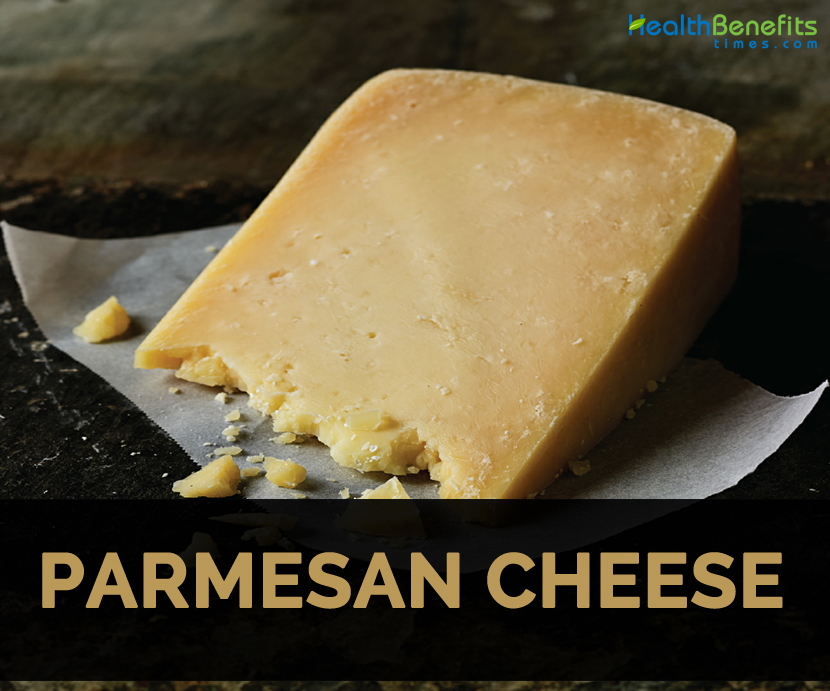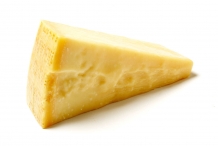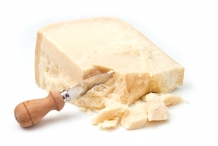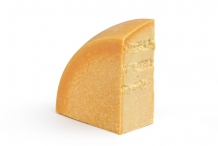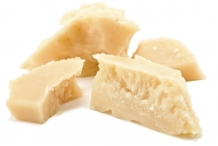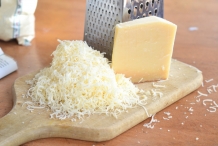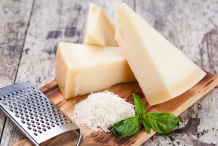| Parmesan Cheese Quick Facts |
| Name: |
Parmesan Cheese |
| Origin |
Italy |
| Taste |
Extremely bitter or acidic |
| Calories |
420 Kcal./cup |
| Major nutrients |
Sodium, Na 1804 mg (120.27%)
Phosphorus, P 627 mg (89.57%)
Valine 1.865 g (88.30%)
Tryptophan 0.383 g (87.05%)
Isoleucine 1.455 g (87.02%)
Calcium, Ca 853 mg (85.30%)
Total Fat (lipid) 27.84 g (79.54%)
Leucine 2.747 g (74.32%)
Lysine 2.201 g (65.82%)
Histidine 0.806 g (65.42%)
|
| Health benefits |
Rich in protein, Easily digested, Brain health, Strengthen immunity, Stronger bones |
Parmesan is familiar to most people as a sharp, hard cheese, usually shredded or grated and used as a garnish or accent. The long aging period develops the flavor. True Parmesan cheese possess hard, gritty texture and has fruity and nutty taste. Inferior Parmesan may have a bitter taste.
Parmesan simply means a dry cheese that’s often used for grating, with a nutty, salty flavor and a crystalline, granular texture that distinguishes it from Cheddar. It is sweeter; its texture moister and mealier; and, ultimately, it has far less acid (sharpness, or piquancy) than Parmigiano-Reggiano. Parmesan cheeses are more like cheese candy. It is used to garnish or with a bit of wine and a bit of lusciously fatty cured pork. While Parmesan is tossed around as an indiscriminate term to describe hard, often Italian-style cheeses, it is decidedly generic and should not be confused with the specific cheese Parmigiano-Reggiano PDO. That being said, it’s the gateway to crunchy, crystalline cheeses that exist at the intersection of sweet, salty, and spicy flavors.
Whole wheels have the ability to age for two or even three years. Once cut, the cheeses of the Parmesan Gateway have a relatively long shelf life. They’re not impermeable. Paper wrap alone (unless it’s specially designed cheese paper) will shorten shelf life because the cheese will rapidly dry out. Plastic zip-top bags are preferred so that all the air could be squeeze out and have individual storage units. Plastic wrap becomes a legitimate possibility here because low-moisture cheeses are more durable than any of the Brie types. Ideally, cheeses in the Parmesan Gateway should be eaten within two weeks of being cut, although they can last for three to four weeks with diminished flavor and complexity. Small spots of blue or green mold may develop on the cut surface of the cheese. These can be easily scraped away and the cheese beneath consumed, although they are a reliable warning sign that you’re pushing the limit on storage life.
Color
The typical color spectrum in the Parmesan Gateway ranges from pale straw to deep orange (as in aged Gouda, shaded with the plant-derived colorant annatto). When you see a sizable (half-inch) perimeter of browning under the rind, you’re looking at an old and dried-out cheese. It’s not spoiled, but it’s not as good as it should be. The exposed, cut face of these cheeses should not have specks of blue or green mold. This is an indication that the cheese has been sitting, precut in plastic, for too long. The mold won’t hurt you and may be scraped off, but the cheese is likely to taste like plastic wrap. To avoid this predicament, especially in a supermarket context, option for cheeses wrapped in a waxy parchment-looking paper by the producer. These are vacuum-sealed and are not likely to have off flavors. Or, go for cheeses that are freshly cut in front of you. It should not have pink streaks or patches of white, blue, or green mold on the cut surface of the cheese.
Flavor
Extremely bitter or acidic flavors are not typical or desirable.
Rind
The rind on these cheeses is waxed and should be removed before eating. Additionally, smushy, smearable, or wet cheeses should be avoided.
History
The records from Benedictine monks demonstrated the existence of this type of cheese over eight centuries ago. Around the Middle Ages, firstly, it was the monks around Parma who made this distinctive hard cheese. Then the people in nobility began to produce it by the Renaissance period for their own consumption. Then it is called in Latin as caseum paramensis that was shortened to Pramsàn by locals. By 1300s, cheese began to go over Tuscany to be traded to other ports in the Mediterranean.
The Italian nobility began to call it Parmesano in the 16th century which indicated its place of origin as Parma. Then it was shortened to Parmesan by the contemporary French court. Guests from Parma gave it as a gift to the French (who developed a special fondness for the cheese).
Then the cheese continued to be known by this name in the following centuries. It was only the matter of time till the name spread and took root beyond France as well.
How to make?
What You’ll Need:
Milk: 2 gal. (8 L) partly skimmed milk (2–2.8% fat)
Culture: ¼ tsp. (0.5 g) Thermo B
Calcium Chloride (optional): ¼ tsp. (1.25 ml) calcium chloride diluted in ¼ cup (30 ml) cool water
Rennet: ¼ tsp. (1.25 ml) double-strength vegetarian rennet diluted just before use in ¼ cup (30 ml) cool, non-chlorinated water
Salt: Heavy brine (recipe in chapter 4) and pure salt
Utensils: Pot, thermometer, ladle, colander, cheesecloth, tray, mechanical or strap press and form, 1 gal. (4 L) vacuum-sealable bag and vacuum sealer
Process in a Nutshell
Time: 2½ hr. active, 11–17 hr. inactive, 4–12 mo. aging
Steps: Heat milk, add culture, ripen, add rennet, ripen and coagulate, cut and stir curd, heat and stir curd, drain and press, salt, age, store and use.
Step by Step
Heat Milk: Pour the milk into the pot, and place the pot over another pot of water on the stovetop. Heat the milk until the temperature reaches 88–90oF (31–32oC).
Add Culture: Sprinkle the culture on top of milk and let set for 3–5 minutes. Using the ladle, stir gently for 2–5 minutes.
Add Calcium Chloride (optional): Stir in the calcium chloride, if using, and let set for 5 minutes.
Add rennet: Stir the milk using an up-and-down motion with the ladle. Stop stirring briefly and pour the diluted rennet over the top of the ladle. Begin stirring again for 1 minute. Hold the ladle to the top of the milk in several spots to help still the milk.
Coagulate: Maintain the temperature of the milk at 88–90oF (31–32oC), and let the curd set until a clean break is achieved, about 30 minutes.
Cut and Stir Curd: Slowly cut the curd mass into ¼-inch (6 mm) cubes over 10 minutes while maintaining the temperature at 88–90oF (31–32oC). Maintain the temperature of the curds and stir gently for 10–15 minutes.
Heat and Stir Curd: Heat the curds very gradually, stirring gently, to 108oF (42oC) over 30 minutes. Maintain the temperature and stir for 5 minutes. Continue stirring and increase the temperature of the curds to 124oF–128oF (51oC–53oC) over 30 minutes. Let settle for 5 minutes.
Drain and Press: Place the form on a tray or drainboard, line the form for the press with cheesecloth, and dampen it with a bit of whey and line with the cheesecloth. Fill the form with the curds, pressing and packing them in by hand. When all of the curds are packed into the form, fold the cloth over the top, and place the follower on top. Place the form in the press. If your press has a screw with a pressure gauge, start with 10 pounds of pressure. If you are using the strap press (see chapter 3 Presses), apply pressure just until you see a bit of white whey coming from the bottom of the form. Press for 15 minutes. The room temperature during draining and pressing should be 68–72oF (20–22oC).
Increase the pressure to 20 pounds or tighten the strap until white whey again comes from the bottom of the form. Press for 15 minutes.
Release the pressure. Remove the cheese from the form, unwrap it, and flip it over. Rearrange the cheesecloth in the form and replace the cheese, pressing the cloth into the form along with it; the rind should be knobby, and you should still see the outline of all of the curds, but the mass shouldn’t fall apart. If the mass starts to fall apart as you handle it, leave it in the form and increase the pressure for 15 more minutes before turning.
Increase the pressure to 30 pounds or tighten the strap very firmly; there should be a lot of resistance from the cheese without a lot of white whey coming out. Press for 1 hour more.
Repeat the steps again; the rind should be closing nicely with only small outlines of the curd. Rewrap the cheese and replace it in the press. Increase the pressure to 50 pounds or tighten the strap about as tight as you can get it and press for 12 hours or overnight.
Remove the cheese from the form, cut off a tiny piece, and taste it. It should have a very mild tang and taste milky with a hint of buttermilk. If it isn’t slightly tangy, press it for 1 hour more and taste it again.
Salt: When you have achieved the desired tang, remove the cheese from the press and place in the container with enough room around all sides for brine. Pour the brine into the container until the cheese floats. Sprinkle a thin layer of salt on top of the cheese. Cover with the lid and let soak for 10 hours. The brine and room temperature should be cool, between 50–60oF (10–15oC).
Age Vacuum Sealed: Pat the cheese dry with paper towels. Place the rack in the tub, place a mat on the rack, and set the cheese on the mat. Put the lid on the tub and place it in a cool place (below 55oF [15oC]) or in the refrigerator or a wine cooler. Flip the cheese daily until the rind dries out a bit, 7–10 days.
Place the cheese in the vacuum-sealable bag, seal it, and place it back in the refrigerator or wine cooler. Check and taste the cheese weekly, making notes about the flavor and texture, if desired. You may have to vacuum more air out of the bag periodically if it loosens as the cheese shrinks.
Age for 4–6 months for a mild cheese and 1 year or more for the most complex results.
Troubleshooting
Cracks in cheese during brining or aging: Because the curds in grana-style cheeses are so small and dry, it can take a lot of pressure to properly knit them back together. Also, make sure that the room doesn’t cool below the suggested temperature during pressing; warmth will help the curds to knit back together.
Health Benefits of Parmesan Cheese
Parmesan cheese is a hard cheese of spectacular savor. It is produced in Northern Italy and is a natural product of high quality. Parmesan cheese is a vital source of essential nutrients such as phosphorus, calcium, magnesium, potassium, Vitamin B and Vitamin A. It provides great amounts of protein, fats and cholesterol. The moderate consumption of Parmesan has beneficial effects on digestive system, supports nervous system and supports brain health and promotes energy levels.
- Rich in protein
About 100 grams of Parmesan cheese provides 32 to 35 grams of protein which is an essential macronutrient necessary for various functions. Protein plays a vital role at cell level such as immune system responses, cell signaling, connective tissue health and DNA repair. Parmesan is regarded to be a complete protein as it provides nine essential amino acids that body could not produce but requires optimal health.
- Easily digested
Parmesan is an aged cheese and due to its lengthy aging process it causes change in structure which makes it easier to digest. The animal food source takes long time period to get digested but it requires little time period for digestion. It is due to aging process which causes protein to break down into free amino acids and shorter chain of amino acids are easily digested. The whitish crystals, sports or gritty which are seed in parmesan are the crystals of amino acids such as isoleucine, leucine or tyrosine.
- Brain health
Parmesan cheese provides great amounts of Vitamin B such as vitamin B12, biotin and choline. Vitamin B modulates brain and nervous system activity by assisting synthesizes neurotransmitters such as serotonin and hormone melatonin regulates sleep. Choline is helpful for preventing neural tube defects in newborns along with Vitamin B12 and folic acid. Vitamin B is crucial for energy metabolism as it synthesize fatty acids and amino acids. The consumption of parmesan promotes the level of energy.
- Strengthen immunity
Parmesan cheese is a great source of Vitamin A which is a fat soluble nutrient with immune boosting properties and antioxidant properties that are essential for strong immune system. Vitamin A contributes good skin health and good eyesight.
- Stronger bones
Parmesan provides vitamin D, magnesium, calcium and phosphorus. All these nutrients have direct action on bone health. About 100 grams of Parmesan cheese contains 1184 mg of calcium which is more than daily recommended allowance for average adult. Calcium goes in composition of bones together with magnesium, phosphorus while vitamin D stimulates absorption of calcium. These nutrients promote strong and healthy bones.
- Acts as prebiotic
Parmesan cheese is a prebiotic food as it is 100% natural dairy product. Due to its prebiotic factor, it nourishes good bacteria in digestive tract and also regulates digestion which contributes good health. As it is made from unpasteurized milk and aged which allows natural fermentation process to support the population of good gut bacteria. As parmesan has less than 1 mg of lactose, it could be consumed by those with lactose intolerant.
- Prevention of cancer
Parmesan cheese contains vitamin B2 which acts as an antioxidant to counteract harmful disease such as cancer. Riboflavin helps the body in regeneration of the damaged body cells and also inhibits the growth of cancer cell.
- Prevents diabetes
The study shows that nutrient value in cheese helps to increase the insulin. The effective amount of insulin will actively inhibit the high sugar within blood. This condition helps to prevent from diabetes, specifically type 2 diabetes.
- Safe for lactose intolerant
Those who are intolerant to lactose that is found in dairy products such as milk could tolerate the dairy products such as cheese. Though dairy milk being the vital ingredient for making parmesan cheese, it is regarded as safe for those who are intolerant to lactose. The recommended consumption of parmesan cheese could be a solution to fulfill dietary calcium need for those who are intolerant to lactose.
- Promotes skin health
Parmesan cheese contains biotin which is a nutrient that supports skin health. Biotin is not produced by the body so we should fulfill the need of biotin by consuming parmesan. Additionally, parmesan cheese contains high content of Vitamin A. Besides skin health, it also supports hair and eye health.
How to Eat
- Parmesan is used as a common seasoning for pizzas and pastas.
- Sprinkle parmesan to the baking tray and then top with grated horseradish or sesame seeds and then bake it in oven till golden and crisp.
- For schnitzels, combine grated parmesan with fresh herbs and breadcrumbs for perfect crumb.
- For extra cheesy flavor, sprinkle parmesan cheese for pasties and pastry pies.
- Sprinkle it over potato wedges with dried herbs and freshly ground pepper then bake it in oven till crisp.
- Place shave parmesan over fresh salad of tomato, cos lettuce, olives and cucumber.
- Grate parmesan over minestrone, potato and leek, ham and pea, vegetable soup or onion.
- Toss the salad of cherry tomatoes, baby spinach, crisp bacon and sliced avocado with lots of shaved parmesan and drizzle with olive oil and vinegar.
- Parmesan cheese could be added to pizza, omelets, fondues and au gratins.
- It could be paired with fruits such as pears, apples and melons.
References:
https://www.cheese.com/parmesan/
https://www.culturesforhealth.com/learn/recipe/cheese-recipes/parmesan-cheese/
https://www.cellowhisps.com/blog/tracing-the-history-of-the-well-loved-parmesan-cheese/
https://www.perfectitaliano.com/nz/products/parmesan-cheese
https://www.tarladalal.com/glossary-parmesan-cheese-314i
https://drhealthbenefits.com/food-bevarages/processed-food/health-benefits-eating-parmesan-cheese
Comments
comments


